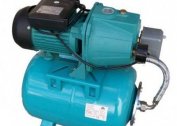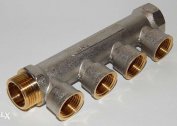Compliance with the regulations for the use of water protection zones is part of a package of measures to protect nature, improve the sanitary and environmental status of water use facilities and improve the near-water area. The rules of operation and maintenance of the water supply system are described in the specialized section of SanPiN, which also establishes sanitary and hygienic standards for environmental facilities.
Water security zone
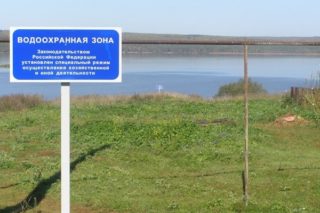 In accordance with the “Water Code of the Russian Federation” dated 03.06.2006. N 74-ФЗ for objects used in drinking and domestic water supply, in order to protect against pollution and ensure sanitary and epidemiological well-being of the population, sanitary zones for the protection of water supply are established. They prohibit or restrict the construction of housing and production assets, the construction of agricultural facilities and the conduct of activities. Sanitary protection zones are installed near waterworks regardless of location.
In accordance with the “Water Code of the Russian Federation” dated 03.06.2006. N 74-ФЗ for objects used in drinking and domestic water supply, in order to protect against pollution and ensure sanitary and epidemiological well-being of the population, sanitary zones for the protection of water supply are established. They prohibit or restrict the construction of housing and production assets, the construction of agricultural facilities and the conduct of activities. Sanitary protection zones are installed near waterworks regardless of location.
The rules for using the water supply system are prescribed in SanPiN 2.1.4.1110-02, which has legal force and is a title document for use by individuals and legal entities.
In terms of the use of water supply, environmental measures are aimed at reducing and reducing pollution. The regulation is aimed at different types of objects:
- superficial;
- underground;
- artificial.
When studying, accounting and applying water use rules, it is necessary to take into account that objects are classified and distributed by zones.
Surface objects
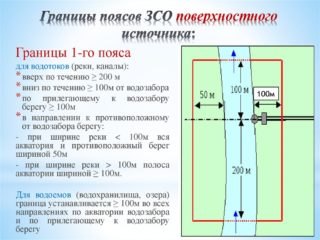 Open water abstraction is considered a surface water use facility.
Open water abstraction is considered a surface water use facility.
- The first belt is a water intake structure. It is considered a sensitive facility with a passage system with a protected adjacent territory, the size of which is determined in accordance with the dimensions of the buildings.
- The second belt imposes restrictions on the territory adjacent to the first, any buildings are prohibited here. The boundary of the belt is determined individually depending on the size of the territory and source, the speed of water movement, which are necessary for self-cleaning of the water body.
- The third belt performs an observational function. There are no restrictions on use, monitoring is ongoing.
Information signs are placed on the borders of the security zones, and a fence is on the boundary zones of the security zones.
Underground objects
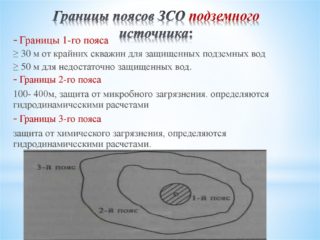 Water intake from wells is defined as underground.
Water intake from wells is defined as underground.
- First belt. The security zone of the water supply according to the SNIP is from 25 to 50 meters. Any structures except those related to water intake are prohibited. These include pumping stations, water towers and outbuildings. Access is granted to employees, specialists, and engineering teams that troubleshoot system problems. The territory is separated by a fence.
- Second belt. It is calculated using hydrodynamic laws and climatic and dendrological conditions, determining the area of possible contamination entering the adjacent territory for a period of one hundred to four hundred days.
- Third belt. Located in the area of residence of people. The estimated operating time of the water well is from 25 to 50 years. Based on the calculations, it is generally accepted that pollution from human activities will reach water intake much later than this period.
The sanitary protection zones of the water supply are marked on the maps and delimited by special signs.
Artificial objects
Water intake from structures outside the water intake is considered to be an artificial object of water use. The sanitary-hygienic protection zones located outside the territory of water intake from natural sources are arranged around:
- filtration stations and spare tanks - up to 30 meters;
- pumping stations, warehouses with chemicals for plumbing and sumps - up to 15 meters;
- water towers - up to 10 meters.
Near the water conduit, sanitary restriction strips with a width of ten to fifty meters are laid depending on the level of the groundwater and the diameter of the water pipes.
If water channels are laid in populated areas, it is allowed to reduce the protection zones based on the results of coordination with the SES.
The area of protected zones of water pipelines is regulated by SanPin 2.1.4.1110-02. The following minimum border sizes have been set:
- not less than five meters from the foundations of buildings and structures;
- at least three meters from poles, fences and roads;
- not less than two meters from the road markings;
- not less than one meter from power transmission towers.
There should be no restrooms, garbage structures, manure storages, waste bins and other structures that can contaminate aquifers in the water protection zones. It is forbidden to construct water conduits in landfills, sewage and filtration fields, industrial enterprises, graveyards and cattle burial places.
Responsibility for violation of protected areas
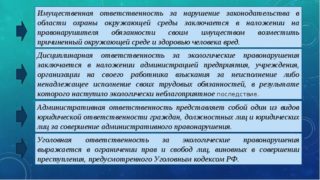 Violation of the rules in the sanitary zone of the water supply system leads to administrative and criminal liability:
Violation of the rules in the sanitary zone of the water supply system leads to administrative and criminal liability:
- Compensation for material damage caused as a result of unauthorized construction, illegal storage and accumulation of garbage in the protected area.
- Penalties for violations of the rules of regulatory documents during construction.
- Criminal punishment is imposed for the seizure of protected areas.
If a violation is detected, an ignorance of the boundaries of the water protection territory is not an excuse. Prior to the commencement of construction or land work, permits should be agreed upon at the water utility branch.
If there are no information signs or other restrictive measures, the operating organization bears responsibility for the safety of the territory. If all informational and barrage elements are present in the sanitary-epidemiological restriction zones, the offender is liable.
In accordance with the Code of Administrative Offenses, a fine is imposed for violation of the regime in protected areas:
- to civilians from 500 to 1 thousand rubles;
- officials from 1 to 2 thousand rubles;
- legal entities from 10 to 20 thousand rubles.
The fines are determined in accordance with the revision of the Federal Law of June 22, 2006 No. 116 - FZ.
Failure to comply with the requirements to bring environmental zones near water pipelines to a condition suitable for use entails liability:
- for individuals 3000 - 5000 r;
- for officials 3000 - 5000 r;
- for legal entities 20,000 - 30,000 p.
As amended by Federal Law No. 282 of October 21, 2013
Non-compliance with the requirements for the protection of water bodies, entailing their pollution or depletion, threatens with a fine:
- for individuals 1500 - 2000r;
- for officials 3000 - 4000r;
- for legal entities 30000 - 40000 rub.
Since ignorance of the law does not exempt from liability, before starting any work, it is necessary to coordinate the project documentation with the regulatory authorities in order to avoid damage to natural resources.
